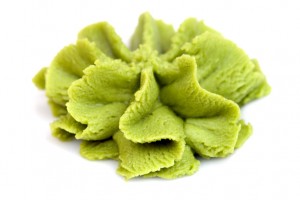By Sayer Ji
Contributing Writer for Wake Up World
A promising new study published in Evidence-Based Complementary and Alternative Medicine titled, “Effect of Wasabi Component 6-(Methylsulfinyl)hexyl Isothiocyanate and Derivatives on Human Pancreatic Cancer Cells,” reveals the potent Japanese horseradish concoction known as wasabi may help fight highly lethal pancreatic cancer by striking to the very root cause of cancer malignancy and its resistance to conventional treatment.
A team of Taiwanese researchers studied the effects of a naturally occurring wasabi isolate, compound 6-(methylsulfinyl)hexyl isothiocyanate (6-MITC), and two of its synthetic derivatives (I7447 and I7557, respectively), on human pancreatic cancer cells. They used two pancreatic cell lines known as PANC-1 and BxPC-3, respectively, and measured their responses to the wasabi derived compounds using the following techniques:
[pro_ad_display_adzone id=”110028″]
– MTT assay for cell viability (i.e. measuring the number of viable cells present)
– Liu’s stain for morphological observation (i.e. changes in cell shape)
– DNA histogram for cell cycle.
– Aldehyde dehydrogenase (ALDH) activity was used as a marker for cancer stem cells (CSC)
– Western blotting was performed for the expression of proteins related to CSC signaling.
Pancreatic cancer is exceedingly difficult to treat through conventional means, with such a poor prognosis that the chance of living past 5 years is only 5-25% even following aggressive treatment.[i] One of the identified mechanisms behind the resistance to conventional treatment is the existence of cancer stem cells (CSCs).
CSCs are a minority subpopulation of cells within tumors capable of limitless self-renewal (i.e. immortality), capable of differentiating into all the cell types that are found in a particular cancer sample, and which are conventional treatment resistant. While chemotherapy, radiotherapy and surgery often shrink (debulk) or ostensibly remove a tumor, below the threshold of diagnostic surveillance, or within the remaining post-intervention tumor, the cancer stem cell population can remain, and in the case of chemotherapy and radiation treatments may actually be enriched in number. This explains why many cancers post-treatment return with even more aggressive metastatic characteristics, despite the original impression of a relapse or treatment success as defined by the reduction of the tumor size.
Given the monumental obstacle that CSCs represent vis-à -vis conventional treatments, CSC targeting therapies are needed more than ever, and can be appreciated for their superiority over conventional therapies which tend to selectively encourage CSC growth, or even convert non-tumorigenic cancer cells within a tumor into cancer stem cells or cancer cells with stem cell like properties. We recently featured a series of articles on this topic, including: Turmeric Extract Strikes To the Root Cause of Cancer, Research: Radiotherapy Causes Cancer, Blueberry Kills It, Broccoli Kills The Stem Cells That Make Cancers Immortal, Chemo and Radiation Can Make Cancer More Malignant, Are Cancer Stem Cells The Key To Discovering A Cure?
The new study found that the two studied wasabi derived compounds (6-MITC and I7557) were capable of reducing the CSC population and reducing the expression of a key CSC signaling molecule known as SOX2, which is a transcription factor found in both undifferentiated embryonic stem cells and cancer stem cells and which is essential for self-renewal and the cell’s ability to differentiate into other cell types (i.e. pluripotency). The study also found that wasabi derived compounds exhibited the following anti-cancer effects:
- 6-MITC and I7557 inhibited viability of both PANC-1 and BxPC-3 cells.
- 6-MITC- and I7557 showed mitotic (cell division) arrest and apoptosis (programmed cell death) in morphological observation.
- 6-MITC and I7557 induced G2/M phase arrest and hypoploid population.
- 6-MITC and I7557 reduced percentages of ALDH-positive PANC-1 cells (Aldehyde dehydrogenase (ALDH) activity is a hallmark of CSCs[ii]).
The authors concluded: “In conclusion, Wasabi compound 6-MITC and its chemical derivative I7557 may possess bioactivity against human pancreatic cancer cells, including the CSC population.”
Article References
[i] Fryer RA, Galustian C, Dalgelish AG. Recent advances and developments in treatment strategies against pancreatic cancer. Current Clinical Pharmacology. 2009;4(2):102–112. [PubMed]
[ii] Kim MP, Fleming JB, Wang H, et al. ALDH activity selectively defines an enhanced tumor-initiating cell population relative to CD133 expression in human pancreatic adenocarcinoma. PLoS ONE. 2011;6(6)e20636 [PMC free article] [PubMed] [Ref list]
Further articles by Sayer Ji:
- Research: Curcumin Is A Triple Negative Breast Cancer Killer
- The Spice That Prevents Fluoride From Destroying Your Brain
- Turmeric Beats Ibuprofen for Arthritis of the Knee
- Live Flu Vaccines Increase Infectious Bacteria Counts 100-Fold in Mice
- FAIL: Another Mammography Study Finds They Don’t Save Lives
- MSG Proven Highly Toxic: 1 Dose Causes Headache In Healthy Subjects
- Black Seed Extract ‘Cures’ HIV Patient Naturally
- The Cancer-Causing Metal Millions Eat, Wear or Have Injected Into Their Kids
- Biophotons: The Human Body Emits, Communicates with, and is Made from Light
- The 2013 Measles Outbreak: A Failing Vaccine, Not A Failure To Vaccinate
- 3 Evidence-Based Ways To Reverse Skin Aging Naturally
- How to Clean Your Arteries With One Simple Fruit
- 13 Evidence-Based Medicinal Properties of Coconut Oil
About the author:
 Sayer Ji is an author, educator, Steering Committee Member of the Global GMO Free Coalition (GGFC), advisory board member of the National Health Federation, and the founder of GreenMedInfo.com – an open access, evidence-based resource supporting natural and integrative modalities. His writings have been published and referenced widely in print and online, including Truthout, Mercola.com, The Journal of Gluten Sensitivity, New York Times and The Well Being Journal.
Sayer Ji is an author, educator, Steering Committee Member of the Global GMO Free Coalition (GGFC), advisory board member of the National Health Federation, and the founder of GreenMedInfo.com – an open access, evidence-based resource supporting natural and integrative modalities. His writings have been published and referenced widely in print and online, including Truthout, Mercola.com, The Journal of Gluten Sensitivity, New York Times and The Well Being Journal.
In 1995 Sayer received a BA degree in Philosophy from Rutgers University, where he studied under the American philosopher Dr. Bruce W. Wilshire, with a focus on the philosophy of science. In 1996, following residency at the Zen Mountain Monastery in upstate New York, he embarked on a 5 year journey of service as a counsellor-teacher and wilderness therapy specialist for various organizations that serve underprivileged and/or adjudicated populations. Since 2003, Sayer has served as a patient advocate and an educator and consultant for the natural health and wellness field.
Connect with Sayer Ji on Google Plus.
Please note: this article is not intended to provide medical advice, diagnosis or treatment.
[pro_ad_display_adzone id=”110027″]







